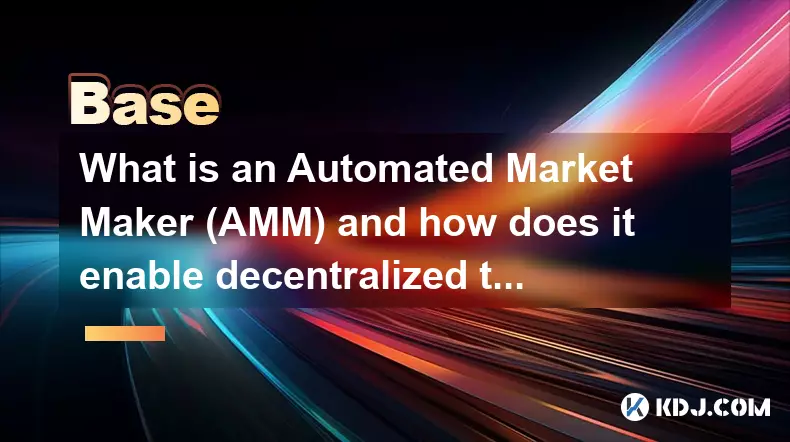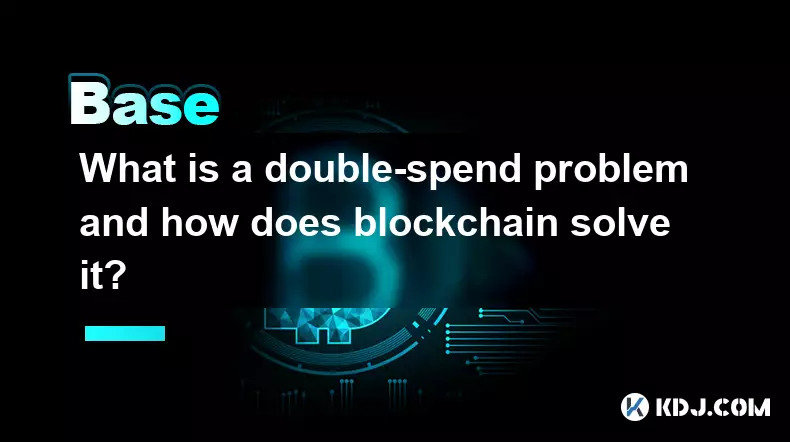-
 bitcoin
bitcoin $100977.009184 USD
-2.05% -
 ethereum
ethereum $3282.009150 USD
-3.23% -
 tether
tether $0.999813 USD
-0.02% -
 xrp
xrp $2.208254 USD
-4.89% -
 bnb
bnb $951.411089 USD
0.55% -
 solana
solana $155.761205 USD
-2.84% -
 usd-coin
usd-coin $1.000217 USD
0.02% -
 tron
tron $0.284475 USD
-1.28% -
 dogecoin
dogecoin $0.162363 USD
-1.53% -
 cardano
cardano $0.533988 USD
-0.47% -
 hyperliquid
hyperliquid $39.174339 USD
-3.22% -
 chainlink
chainlink $14.724828 USD
-1.16% -
 bitcoin-cash
bitcoin-cash $477.297986 USD
-1.28% -
 zcash
zcash $554.227426 USD
17.30% -
 ethena-usde
ethena-usde $0.998995 USD
-0.03%
What is an Automated Market Maker (AMM) and how does it enable decentralized trading?
Automated Market Makers (AMMs) enable decentralized trading via liquidity pools and algorithmic pricing, allowing anyone to provide liquidity and trade tokens without intermediaries.
Nov 07, 2025 at 04:39 pm

Understanding Automated Market Makers (AMMs)
1. An Automated Market Maker (AMM) is a type of decentralized exchange (DEX) protocol that relies on mathematical formulas to price assets. Unlike traditional exchanges that use order books, AMMs utilize liquidity pools where users contribute funds to facilitate trading.
2. The most common pricing formula used in AMMs is the constant product formula: x * y = k. In this equation, x and y represent the quantities of two different tokens in a liquidity pool, and k is a constant. This ensures that the product of the two token reserves remains unchanged during trades.
3. When a trader swaps one token for another, the ratio of the tokens in the pool changes, which automatically adjusts the price based on supply and demand dynamics embedded in the formula. The larger the trade size relative to the pool, the more significant the price impact.
4. Because pricing is algorithmic, there is no need for buyers and sellers to be present simultaneously. This enables continuous trading without relying on centralized intermediaries or matching engines.
5. Early examples of AMMs include Uniswap, Curve, and Balancer, each modifying the core model to suit different asset types—such as stablecoins or index-like portfolios—by adjusting their underlying pricing mechanisms.
Liquidity Provision and Incentives
1. Liquidity providers (LPs) deposit an equivalent value of two tokens into a pool and receive LP tokens in return, representing their share of the pool. These LP tokens can later be redeemed for their portion of the total assets, including accumulated fees.
2. Traders pay a small fee on each swap, which is distributed proportionally to liquidity providers. This creates a financial incentive for users to supply liquidity, ensuring sufficient depth for smooth trading operations.
3. One key innovation of AMMs is democratizing market-making, allowing anyone with tokens to earn passive income by becoming a liquidity provider, regardless of their capital size or technical expertise.
4. Some platforms introduce additional incentives through yield farming, where LPs earn governance tokens or other rewards on top of trading fees, further boosting participation.
5. However, providing liquidity carries risks such as impermanent loss, which occurs when the price of deposited tokens changes significantly compared to when they were added to the pool, potentially resulting in lower value than holding the assets outside the pool.
Decentralized Trading Enabled by AMMs
1. AMMs eliminate reliance on centralized entities to manage order books or custody user funds. Instead, smart contracts execute all trades automatically, governed by transparent and immutable code deployed on blockchains like Ethereum.
2. Users interact directly with these smart contracts using wallets like MetaMask, enabling peer-to-contract trading. This removes counterparty risk associated with centralized custodians and enhances user control over assets.
3. By decentralizing both infrastructure and access, AMMs empower global users to trade permissionlessly, without identity verification or geographic restrictions, fostering greater financial inclusion.
4. Integration with other DeFi protocols allows for composability—AMM liquidity can be used as collateral, leveraged in lending markets, or routed across multiple platforms via aggregators to achieve optimal swap rates.
5. Due to open-source nature, anyone can audit the code, create forks, or build new interfaces on top of existing AMMs, accelerating innovation and competition within the ecosystem.
Frequently Asked Questions
How do AMMs handle price discovery without an order book?AMMs derive prices from the ratio of assets in liquidity pools using predefined mathematical functions. As trades occur, the balance shifts, and the algorithm recalculates the price accordingly, mimicking supply-demand dynamics seen in traditional markets but in a continuous and automated fashion.
What prevents arbitrage opportunities in AMM systems?Arbitrageurs actively monitor price discrepancies between AMMs and external markets. When a deviation occurs, they execute trades to profit from the difference, which simultaneously corrects the pool’s price back in line with market rates. This mechanism keeps AMM prices aligned with broader market conditions.
Can AMMs support complex trading orders like limit or stop-loss?Native AMM smart contracts typically only support instant swaps at current market rates. However, third-party tools and advanced DeFi interfaces have emerged to simulate limit orders by monitoring prices and executing transactions when certain thresholds are met, though this requires off-chain logic and user-initiated triggers.
Disclaimer:info@kdj.com
The information provided is not trading advice. kdj.com does not assume any responsibility for any investments made based on the information provided in this article. Cryptocurrencies are highly volatile and it is highly recommended that you invest with caution after thorough research!
If you believe that the content used on this website infringes your copyright, please contact us immediately (info@kdj.com) and we will delete it promptly.
- BlockDAG, Avalanche, Dogecoin: Crypto's Leading Trio in 2025
- 2025-11-07 22:05:01
- Layer 2 Coins: Will There Be a Potential Explosion by 2026?
- 2025-11-07 16:50:02
- Filecoin, ICP, and the AI Infrastructure Renaissance: Is History Repeating?
- 2025-11-07 16:50:02
- Bitcoin's Wild Ride: Surges, Zeros, and the Search for Stability
- 2025-11-07 17:05:01
- XRP, Bitcoin, and the Rally: What's the Deal, New York?
- 2025-11-07 17:25:01
- Filecoin, DePIN, and a Technical Breakout: What's the Buzz?
- 2025-11-07 17:05:01
Related knowledge

How does a crypto insurance protocol work?
Nov 08,2025 at 12:39am
Understanding Crypto Insurance Protocols1. A crypto insurance protocol operates by offering financial protection against losses incurred from digital ...

What is a decentralized storage network and how does it compare to cloud services?
Nov 07,2025 at 11:59pm
Understanding Decentralized Storage Networks1. A decentralized storage network distributes data across a peer-to-peer infrastructure rather than relyi...

What is liquid restaking and how does it build upon the concept of staking?
Nov 07,2025 at 06:19pm
Bitcoin’s Role in Decentralized Finance Evolution1. Bitcoin remains the cornerstone of decentralized finance, setting benchmarks for security and netw...

What is a concentrated liquidity position and how does it improve capital efficiency?
Nov 07,2025 at 06:00pm
Understanding Concentrated Liquidity Positions1. A concentrated liquidity position allows liquidity providers to allocate their capital within a speci...

What is an initial DEX offering (IDO) and how do you participate?
Nov 07,2025 at 06:59pm
Understanding Initial DEX Offerings (IDOs)1. An initial DEX offering (IDO) is a fundraising mechanism used by blockchain projects to launch their toke...

What is a double-spend problem and how does blockchain solve it?
Nov 07,2025 at 05:19pm
Understanding the Double-Spend Problem1. The double-spend problem refers to a scenario in digital currencies where the same set of funds is spent more...

How does a crypto insurance protocol work?
Nov 08,2025 at 12:39am
Understanding Crypto Insurance Protocols1. A crypto insurance protocol operates by offering financial protection against losses incurred from digital ...

What is a decentralized storage network and how does it compare to cloud services?
Nov 07,2025 at 11:59pm
Understanding Decentralized Storage Networks1. A decentralized storage network distributes data across a peer-to-peer infrastructure rather than relyi...

What is liquid restaking and how does it build upon the concept of staking?
Nov 07,2025 at 06:19pm
Bitcoin’s Role in Decentralized Finance Evolution1. Bitcoin remains the cornerstone of decentralized finance, setting benchmarks for security and netw...

What is a concentrated liquidity position and how does it improve capital efficiency?
Nov 07,2025 at 06:00pm
Understanding Concentrated Liquidity Positions1. A concentrated liquidity position allows liquidity providers to allocate their capital within a speci...

What is an initial DEX offering (IDO) and how do you participate?
Nov 07,2025 at 06:59pm
Understanding Initial DEX Offerings (IDOs)1. An initial DEX offering (IDO) is a fundraising mechanism used by blockchain projects to launch their toke...

What is a double-spend problem and how does blockchain solve it?
Nov 07,2025 at 05:19pm
Understanding the Double-Spend Problem1. The double-spend problem refers to a scenario in digital currencies where the same set of funds is spent more...
See all articles





















![The Graph Price Prediction [GRT Crypto Price News Today] The Graph Price Prediction [GRT Crypto Price News Today]](/uploads/2025/11/07/cryptocurrencies-news/videos/690d4df44fe69_image_500_375.webp)




















































